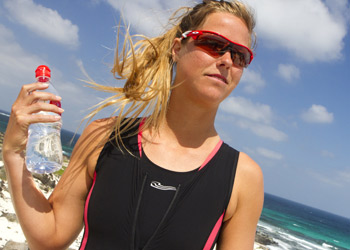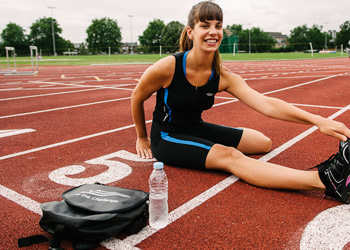Keeping Yourself Hydrated – a Guide for Women Triathletes
by Jo Scott-Dalgleish, Nutritional Therapist
 There’s no getting away from it – taking part in triathlon is a sweaty business!
There’s no getting away from it – taking part in triathlon is a sweaty business!
When you sweat as a result of vigorous physical activity like cycling or running and, yes, even swimming, you lose some of your body’s water stores through your skin and with it some of your body’s supply of electrolyte minerals like sodium, potassium, magnesium and calcium, which are required to regulate fluid balance, muscle contraction and nerve function and must be obtained through food and fluid.
The purpose of perspiration is to help your body to cool itself and so prevent over-heating, and it’s a vital metabolic process. But in order to maintain the necessary balance of water and electrolytes in your body, you need to pay attention to your hydration before, during and after training or competing.
The first step is to become aware of your body’s needs for fluids and electrolytes. Everyone is different. The amount that you need to drink is likely to be different from the amount that your friend does. For this reason, there are no ‘rules’ on hydration which you need to follow slavishly. But you do need to develop good habits like considering how much you personally need to drink before and after a training session…and remembering to do it!
You also need to practise drinking while riding your bike and while running if you are going to be competing in any distance longer than a sprint triathlon. Some people find this easier than others. I’ve dropped a water bottle several times while trying to put it back in the cage on my bike, not something that you want to happen during a race!
When preparing for a training session, think about the following:
- When did I last drink a glass of water or a hot drink? Both contribute to your body’s fluid status. If your urine is a dark yellow colour, it’s a sign of dehydration and you should take on some more fluid before you start to train.
- How long am I going to be training for? If it’s more than hour, you need to carry water or a sports drink with you or know where you can obtain it en route.
- How tough is my session? If you are doing intervals on the track, an intense ride on the turbo trainer or a masters swim session, make sure that you have some water close at hand to rehydrate when you feel thirsty.
- How warm is it? If it’s a hot, sunny day you are likely to sweat more heavily and so need both to start your training with a higher level of hydration and to have more fluid, and possibly electrolytes, available to top yourself up.
- Am I a naturally heavy or salty sweater? Some ladies perspire more than others. If you are one of them, you will need to drink more than your friends. If you find that you often have white stains on your sports kits after training, it’s a sign that you lose quite a high level of salt and may need to use electrolyte tablets in your water bottle.
- How will I rehydrate after training? If you are back at home or in the office, it’s simple. But if you won’t have easy access to water or a recovery drink after training, be prepared and take a bottle with you. Drink this within 30 minutes of finishing your session. Then drink more water in small amounts over the course of the day until your urine runs clear when you next visit the toilet.
During your session, you should drink according to your thirst. The guidelines on rehydration have changed in recent years. In the early 1990s, endurance sports participants were encouraged to drink as much as possible to minimise fluid losses. This advice was later changed to knowing your personal dehydration pattern by weighing yourself before and after exercise, and drinking enough to prevent more than 2% loss of body fluids, as greater than this had been shown by research to adversely affect performance.

The most up to date guidance, however, is to drink as and when you need to. More recent research has shown that the relationship between dehydration and performance is very individual. Some elite marathon runners have been found to lose up to 9% of their body weight through fluid loss during races. The best strategy is to monitor how much you need to drink in various different training sessions, and then use this information to help you create a personal hydration plan for race day.
One of the reasons that the hydration guidelines have changed is concern around a medical condition called hyponatremia. This occurs when you overhydrate and dilute your body’s sodium stores to the extent that you start to experience unpleasant and potentially dangerous symptoms such as nausea, vomiting, headaches and swollen limbs, which can result in collapse or even be fatal.
It has been found that women competing in endurance events are more prone to hyponatremia than men. This is thought to be because they are smaller, sometimes slower and therefore more likely to over-drink during long races. If you are competing at the Ironman or Half-Ironman distance in particular, it’s very important not to over-drink and also to replenish the sodium lost in sweat through consuming a sports drinks, gels or energy bars with added sodium as part of your race nutrition plan.
When it comes to race day, the most important aspect of hydration is to have some idea of how much you are likely to need to drink and how you are going to supply that fluid. Remember that you will be working at a higher intensity than in most training sessions, and that this will influence your hydration requirements. Have a rough plan of how much fluid you will need per hour, and how much of that needs to include some carbohydrate in order to meet your fuelling needs.
It can be a good idea to carry one bottle of sports drink and one bottle of water on the bike. Check your briefing pack and know where the aid stations will be or where a water bottle can be refuelled. If you are carrying gels, make sure that you have some water available to wash them down, unless they are the isotonic type that already contains water.
In the last two hours before the race, aim to drink around 500ml of water – which might be in a sports drink – sipping little and often, rather than swigging it back. Check your urine colour on your last toilet visit, drinking a little more if you need to.